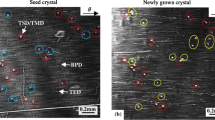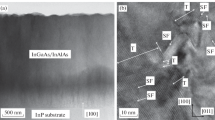Abstract
InSb p-i-n structures were grown on an undoped InSb wafer in a horizontal metal organic vapour phase epitaxy reactor. 200 to 300 nm thick layers were fabricated using silane and zinc as dopant sources for the n-type and p-type layers, respectively. The defects of these samples were studied using synchrotron X-ray topography in large area transmission and transmission section geometries. Pendellösung fringes typical of a nearly perfect crystal were seen in the transmission section topographs. Large area transmission topographs showed dynamical diffraction images of voids and precipitates. Also straight and circular arc dislocations were observed. Most of the images seen in the topographs arise from the defects in the epilayers. Assuming that all precipitates and voids of the layer have been imaged the average precipitate and void density was calculated to be 4000 cm−2 or 2 × 108 cm−3 in the best sample.
Similar content being viewed by others
References
Editor O. MADELUNG, “Data in Science and Technology, Semiconductors Group IV Elements and III-V Compounds” (Springer, Berlin, 1991) p. 141.
W. C. HARRIS, Nucl. Instrum. Methods Phys. Res. A 242 (1986) 373.
I. KANNO, F. YOSHIHARA, R. NOUCHI, O. SUGIURA, T. NAKAMURA and M. KATAGIRI, Rev. Sci. Instrum. 73 (2002) 2533.
I. KANNO, F. YOSHIHARA, R. NOUCHI, O. SUGIURA, Y. MURASE, T. NAKAMURA and M. KATAGIRI, Rev. Sci. Instrum. 74 (2003) 3968.
T. TUOMI, J. Synchr. Radiation 9 (2002) 174.
T. TUOMI, K. NAUKKARINEN and P. RABE, Phys. Stat. Sol. (A) 25 (1974) 93.
T. TUOMI, R. RANTAMÄ KI, P. J. MCNALLY, D. LOWNEY, A. N. DANILEWSKY and P. BECKER, J. Phys. D: Appl. Phys. 34 (2001) A133.
T. TUOMI, L. KNUUTTILA, J. RIIKONEN, P. J. MCNALLY, W.-M. CHEN, J. KANATHARANA, M. NEUBERT and P. RUDOLPH, J. Cryst. Growth 237–239 (2002) 350.
R. M. BIEFELD, ibid. 77 (1986) 392.
A. AARDVARK, N. J. MASON and P. J. WALKER, Prog. Cryst. Growth Charact. 35 (1997) 207.
T. TUOMI, M. TILLI, V. KELHÄ and J. D. STEPHENSON, Phys. Stat. Sol. A 50 (1978) 427.
A. AUTHIER, “Dynamical Theory of X-Ray Diffraction” (Oxford University Press, 2001) p. 144.
Editor K. LONSDALE, “International Tables for X-ray Crystallography 3: Physical and Chemical Tables” (Dordrecht, Reidel, 1985)
Author information
Authors and Affiliations
Corresponding author
Rights and permissions
About this article
Cite this article
Riikonen, J., Tuomi, T., Lankinen, A. et al. Synchrotron X-ray topography study of defects in indium antimonide P-I-N structures grown by metal organic vapour phase epitaxy. J Mater Sci: Mater Electron 16, 449–453 (2005). https://doi.org/10.1007/s10854-005-2313-5
Received:
Accepted:
Issue Date:
DOI: https://doi.org/10.1007/s10854-005-2313-5




